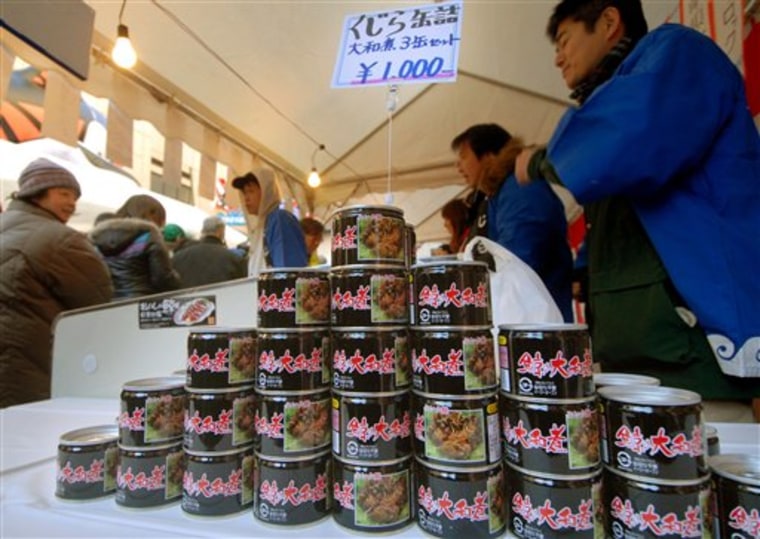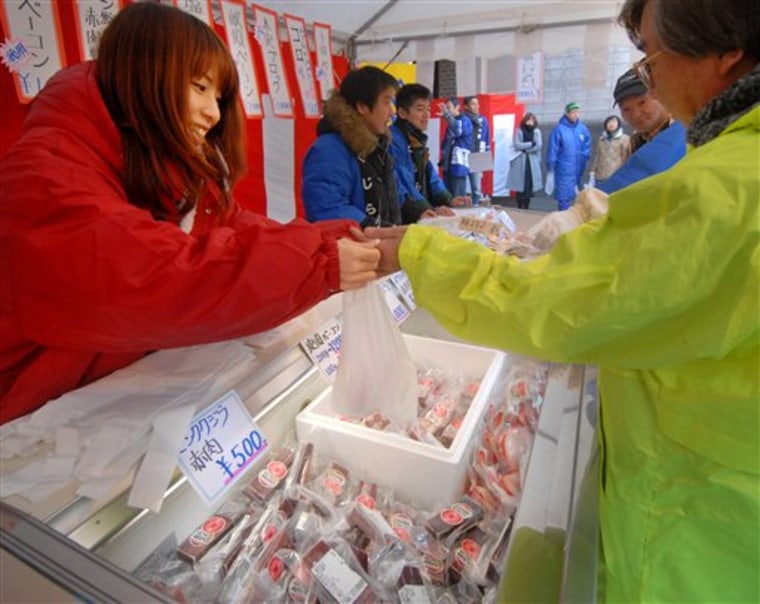Japan has enticed children with whale burger school lunches, sung the praises of the red meat in colorful pamphlets, and declared whale hunting “a national heritage.”
But Tokyo has a dilemma: by rapidly expanding its whale hunt, Japan now kills more of the giant mammals than its consumers care to eat.
The result is an unprecedented glut of whale meat. Prices — once about $15 a pound — are plunging, inventories are bursting, and promoters are scrambling to get Japanese to eat more whale.
It’s a tough sell.
“To put it simply, whale meat tastes horrible,” said 30-year-old Kosuke Nakamura, one of the diners at a Hana No Mai restaurant in Tokyo who turned their noses up at whale meat.
Young people are put off by the tough, pungent meat, Nakamura said, while older Japanese are reminded of the lean years after the country’s defeat in World War II.
And while few Japanese voice environmental concerns over hunting whales, some younger people say it has brought the country unfavorable publicity.
“Whaling’s so bad for Japan’s image. I don’t know why we still hunt,” Nakamura said.
Some 1,035 tons of whale meat hit the market in Japan last year, a 65 percent increase from 1995, the Fisheries Agency says. And sluggish demand means inventories have almost doubled in five years to 2,704 tons in 2004.
In the same period, the average price of whale fell almost 30 percent, to just over $10 a pound in 2004. That’s more than the average price for beef — about $9 a pound — and far higher than for chicken or pork.
Hunt grows
But the glut of whale meat hasn’t stopped the harpoon guns. Tokyo plans to kill — under a research program — some 1,070 minke whales in 2006, over 400 more than last year. Japan will also hunt 10 fin whales, and a total of 160 Bryde’s, sei and sperm whales, fisheries official Kenji Masuda said.
The International Whaling Commission banned commercial whaling in 1986, approving limited hunts for research purposes a year later. Opponents have called Japan’s hunts merely a way for it to dodge the whaling ban.

Tokyo says its program is needed to establish reliable information on whale populations and habits — data Japan says can only be gleaned by killing the animals.
The government, which distributes the meat and uses profits to fund research, is working to promote whale meat and secure new distribution channels.
“Is it OK to eat whale meat? Of course it is,” reads a pamphlet titled “Delicious Whales” that is distributed by the government-affiliated Japan Whaling Association.
“Even if we capture 2,000 whales a year for 100 years, it’s OK because whale numbers are growing,” the pamphlet says.
The association acknowledges whale is a hard sell. The meat was considered a rich source of protein in the lean years after World War II, but people moved on to other meats — notably beef — as they became more affluent.
Whale meatballs at school
Some local governments have begun offering whale meat in school lunches.
Wakayama, a prefecture with a whale-hunting tradition 280 miles southwest of Tokyo, has been aggressive in getting youngsters to eat whale, introducing whale meals at 270 public schools in 2005.
Nutritionists have even developed child-friendly whale dishes, including whale meatballs, hamburgers and whale spaghetti bolognese, said Tetsuji Sawada of Wakayama’s education board.
Chimney Co., which runs the Hana No Mai eateries, acknowledges customers are wary of new whale dishes.
Still, Hana No Mai will keep selling whale meat. And a trader at one of Tsukiji market’s biggest wholesalers, Daito Gyorui Co., was equally optimistic.
“The fall in prices is a good thing because it will make whale meat more accessible,” Yoshiaki Kochi said. “Japanese will never forget the taste of whale. It’s part of our culture. It’s in our DNA.”
